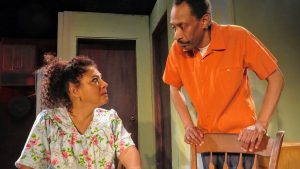
Space Dogs (MCC Theater)
As we absorb the current news cycle of the threatened invasion of Ukraine by Russia, the Cold War decades return in sharp focus. Depending on the political party in power (and their news media outlets), Russia is either a friend or foe of the United States. Back when “foe” was the generally accepted viewpoint there were many psychological battles being fought. One was the race to outer space. The new musical Space Dogs reminds us of a simpler time where all we had to worry about was nuclear annihilation.
Van Hughes and Nick Blaemire have written and star in this cabaret of songs, skits and excessive cuteness. Many dogs were trained for this mission but only one could be the first. Stuffed animals are thrown into the audience. It’s an Oprah-ish “you getta dog and you getta dog” vibe. The start is silly but engaging.
A tag line lyric informs that space dogs of the Cosmodrome “ain’t nobody’s bitch.” While there are moments to chuckle, there are also tunes which rhyme “fill the void” with “you can’t avoid”. The songs in this show do not have the cleverness that the winning conceit demands. As a result, the musical stumbles, becomes repetitive and devolves into an overlong self-aware review.
The production design by Stefania Bulbarella and Alex Basco Koch, however, gives this material a shiny finish and elevates the visual interest substantially. The scenic design (Wilson Chin) adds to the fun factor. The nuclear war imagery hits the mark and briefly reminds us of a bygone era. Many moons ago when children practiced school drills hiding under desks.
Ellie Heyman’s direction wisely keeps the two performers constantly moving, playing their songs and changing characters. Mr. Blaemire’s Werner Von Braun characterization was a highlight. No amount of kinetic energy can cover up a musical where the songs are the least interesting aspect. The show could clearly benefit from more SNL tinged goofiness but that would not send this forgettable piece into orbit.
Space Dogs is running at MCC Theater through March 13, 2022.










You must be logged in to post a comment.